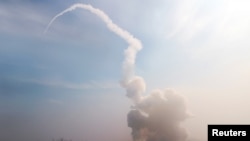Western experts analyzing North Korea’s latest intercontinental ballistic missile tests are watching to see whether Pyongyang will follow up by firing an ICBM into the Pacific Ocean on a flat trajectory more like a real attack on the United States.
Such a test would be intended to demonstrate North Korea’s ability to reach the mainland United States with a nuclear weapon as well as to gauge whether the Biden administration would try to intercept it, the experts told VOA’s Korean service.
North Korea said it launched a Hwasong-17 ICBM on March 16 to "give a stronger warning" to the U.S. and South Korea, saying those nations were escalating tensions on the Korean Peninsula with large-scale military drills. The allies were three days into their 11-day Freedom Shield live exercises that Pyongyang views as a rehearsal for an invasion.
The Hwasong-17 was fired into space on a trajectory that sent it to over 6,000 kilometers in altitude and about 1,000 kilometers in distance before it splashed into the waters off North Korea’s eastern coast, according to state media.
North Korea has not conducted a full-range test of its ICBMs involving longer and lower flight paths as if they were aimed at a distant adversary. The country has tested them only on a lofted trajectory.
Experts said North Korea may test fire either its Hwasong-17 or Hwasong-15 to full range into the Pacific Ocean to demonstrate its capability to target the United States. North Korea said it launched the Hwasong-15 ICBM in February.
The Hwasong-17 has a maximum range of 15,000 kilometers, which means it is capable of hitting targets anywhere in the U.S. The Hwasong-15 has the range of about 13,000 kilometers, making it capable of reaching almost all of the continental U.S.
Jonathan McDowell, a satellite and space expert at the Harvard-Smithsonian Center for Astrophysics, said, "It's quite likely they could do such a test."
The astrophysicist continued to say that North Korea could test fire a Hwasong-17 into the Pacific, in international waters near Hawaii.
Proving capability
In December, Kim Yo Jong, the powerful sister of North Korean leader Kim Jong Un, said the country could launch an ICBM on a high angle "to clear up" any "doubts" about its capability.
In February, she said North Korea could use the Pacific Ocean as a "firing range" to aim its missiles.
Bruce Bechtol, a former intelligence officer at the U.S. Defense Intelligence Agency and now a professor at Angelo University in Texas, said the goal of undertaking a full-range ICBM test aimed at the Pacific would be to prove the missile has the capability of reaching the U.S.
"What that does is it demonstrates definitively that North Korea has the capability to do what it claims it can do, which is firing a missile at a long enough range successfully that it could hit the United States," said Bechtol. "The Hwasong-15 and the Hwasong-17 serve one purpose and one purpose only, and that is to strike American territory."
Decision to intercept
Experts say President Joe Biden needs to decide whether to authorize an interception if North Korea fires an ICBM on an operational trajectory.
Bruce Bennett, a senior defense analyst at the RAND Corporation, said it is uncertain "whether President Biden is prepared to do that after Kim Yo Jong said that would be an act of war." He continued, "We have to show North Korea that [it] can't keep doing these extreme provocations, but we can't be sure that President Biden would have the courage to do that."
On March 7, Kim Yo Jong said, "It will be regarded as a clear declaration of war against the DPRK, in case such military response as interception takes place against our tests of strategic weapons that are conducted without being detrimental to the security of neighboring countries in the open waters and air which do not belong to the U.S. jurisdiction."
The DPRK stands for North Korea's official name, the Democratic People's Republic of Korea.
David Maxwell, vice president of the Center for Asia Pacific Strategy, said, "We may not have any missile defense assets in the proper location to shoot down a missile that is targeting the middle of the Pacific Ocean."
Maxwell continued, "If it is not tracking to a target in the U.S. or allies' territory, we are unlikely to shoot it down because our defensive capabilities only extend to U.S. and allied territory."
Where in Pacific
Bennett said the U.S. is less likely to intercept a missile if North Korea launches it below the equator into the South Pacific.
However, he said, "If it goes near Hawaii, the chance that it could be intercepted goes up a whole lot."
He continued, "The U.S. would find some serious incentives for intercepting it because we don't know if it has a nuclear warhead on it. What happens if Kim decides to test his seventh nuclear test by putting it on a ballistic missile and shooting it out over the Pacific?"
Maxwell said, "It is unlikely that we will know whether a missile is carrying a nuclear payload unless we have very good intelligence."
Targeting a location in the ocean near Hawaii would demonstrate a range of only about 7,000 kilometers, Bennett said.










